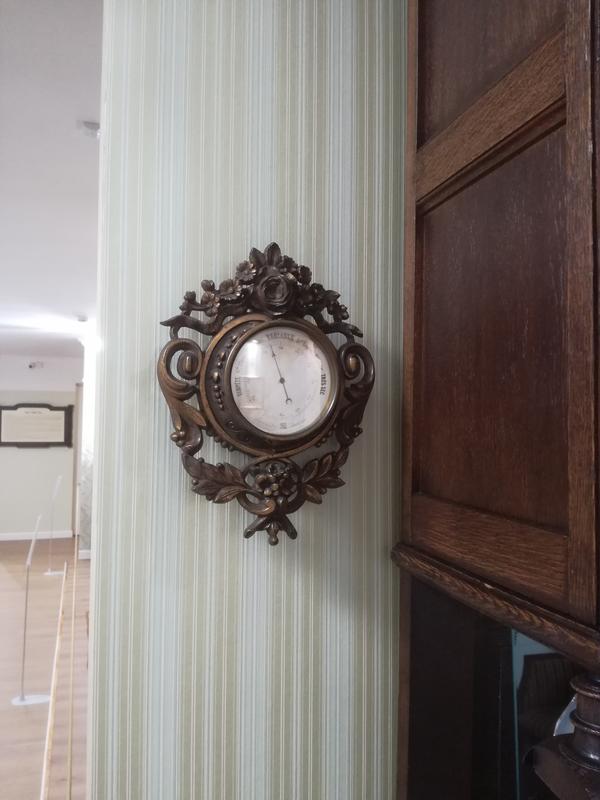The idea of building a device for predicting the weather was already in the minds of the scientists as far back as the time of Galileo Galilei (1564–642). The inventor himself focused only on the theory, but his pupil Evangelista Torricelli and his assistant Vincenzo Viviani succeeded in putting it into practice.
In 1643, Torricelli carried out a scientific experiment to prove the fact of atmospheric pressure. When a sealed flask with mercury was immersed in a vessel with the same substance, the mercury in the flask rose to a height of 760 mm (this became the standard level of pressure). As the pressure changed, the mercury in the flask dropped and rose accordingly. The first mercury barometer (from Greek βάρος “gravity” and μετρέω “I measure”) — a device that measures air pressure — was created on the basis of this experience.
The device, in the form of a transparent tube with markings and mercury inside, was so accurate that it is still used by meteorologists today. It was not popular with ordinary people because of the risk of spilling the hazardous substance.
In 1670, the Englishman Robert Hooke created a barometer scale which made it possible to clearly gauge the onset of sunny and dry or rainy weather. In the first case, the scale readings would go up, in the second, they would go down.
In 1657–1660 Otto von Guericke was developing a water barometer and, using it, managed to predict the coming storm. However, the device was rather complicated to use.
In the 17th century, Gottfried Wilhelm von Leibniz was the first to articulate the idea of an aneroid barometer (from the Greek a + nērós “waterless”), but failed to implement it. The French engineer Lucien Vidie was the one who did it in 1847. His invention featured a sealed cylinder of metal with thin air. It was less accurate than its mercury-powered predecessor, but safer and more suitable for domestic use.
The first barometer was brought to Russia from Italy during the reign of Tsar Alexey Mikhailovich as an overseas curiosity. It was seen as such and its readings were overlooked. Only under Peter the Great in 1725 were regular meteorological observations established.
Barometers were common in almost every home: the device was not only useful, it was also a piece of decor in a room. For its frame, craftsmen often used tinted lacquered walnut or oak with bronze plates and inlays. The barometer on display is made of cast iron.
In 1643, Torricelli carried out a scientific experiment to prove the fact of atmospheric pressure. When a sealed flask with mercury was immersed in a vessel with the same substance, the mercury in the flask rose to a height of 760 mm (this became the standard level of pressure). As the pressure changed, the mercury in the flask dropped and rose accordingly. The first mercury barometer (from Greek βάρος “gravity” and μετρέω “I measure”) — a device that measures air pressure — was created on the basis of this experience.
The device, in the form of a transparent tube with markings and mercury inside, was so accurate that it is still used by meteorologists today. It was not popular with ordinary people because of the risk of spilling the hazardous substance.
In 1670, the Englishman Robert Hooke created a barometer scale which made it possible to clearly gauge the onset of sunny and dry or rainy weather. In the first case, the scale readings would go up, in the second, they would go down.
In 1657–1660 Otto von Guericke was developing a water barometer and, using it, managed to predict the coming storm. However, the device was rather complicated to use.
In the 17th century, Gottfried Wilhelm von Leibniz was the first to articulate the idea of an aneroid barometer (from the Greek a + nērós “waterless”), but failed to implement it. The French engineer Lucien Vidie was the one who did it in 1847. His invention featured a sealed cylinder of metal with thin air. It was less accurate than its mercury-powered predecessor, but safer and more suitable for domestic use.
The first barometer was brought to Russia from Italy during the reign of Tsar Alexey Mikhailovich as an overseas curiosity. It was seen as such and its readings were overlooked. Only under Peter the Great in 1725 were regular meteorological observations established.
Barometers were common in almost every home: the device was not only useful, it was also a piece of decor in a room. For its frame, craftsmen often used tinted lacquered walnut or oak with bronze plates and inlays. The barometer on display is made of cast iron.



